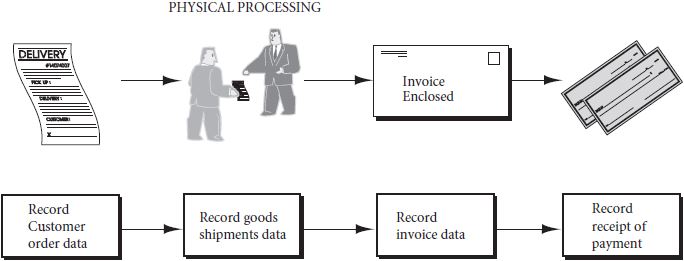In Chapter 2, we studied several types of diagrams in which something happened (e.g., a customer order) that triggered a series of human and automated business activities. These business activities represent the occurrence of a business event. Every firm has a number of business events that link together to form a business process. The nature of a firm’s business dictates the range of processes it can adopt to achieve its objectives. The firm’s information system will collect, process, and store business event data in support of its business processes. Each of these business processes may be divided into components, or subprocesses.
Take, for instance, a merchandising firm. A merchandising firm is an organization (e.g., a store) that buys goods from vendors and resells those goods to customers. On the customer side, its business events within the Order-to-Sales process include:
- Capturing and recording of customer orders
- Shipment of goods and recording of sales
- Sending invoices for goods and recording the amount to be received
- Receipt and recording of payments
Figure 3.1 depicts how the physical processing of these business events is also captured in the data recorded and processed by the merchandising firm’s information system. On the supplier end, business events within the Purchase-to-Pay process include:
- Preparation and recording of purchase orders
- Receipt of goods into inventory and recording the receipt of inventory
- Receipt of vendor invoices and recording of the amount owed
- Preparation and recording of payments
|
Review Question What business events are typically encountered by a merchandising firm? |
There may be other business processes in a typical merchandising business, such as payroll processing, hiring new employees, and many more.
As another example, a service firm is an organization that sells services, rather than merchandise, to its customers. The business events for a service firm that parallel the Order-to-Sales process include:
- Recording of customer services performed
- Billing for services rendered
- Receipt and recording of payments

|
Review Question How do the business events for a service firm differ from those of a merchandising firm? How are they similar for the two firms? |
Because there is no physical exchange of goods in a service firm, its Order-to-Cash process would have a slightly modified set of events reflected in its corresponding information system, as shown in Figure 3.2. Service firms also must record other business events, including the purchase of materials used in the performance of service engagements and payroll disbursements.
A manufacturing firm acquires raw materials, converts those materials into finished goods, and sells those goods to its customers. Its production process includes recording activities related to the manufacture of goods for sale. A manufacturing firm must also receive customer orders, record sales, send invoices, and receive customer payments. Its Order-to-Cash process is essentially the same as that of the merchandising firm in Figure 3.1. The events that make up these processes will be described in detail in Chapters 10–14.
As each business event occurs, a firm must record at least a minimal set of data about the event so that it can maintain records and produce reports that help assess how well it is meeting its objectives. Today, virtually all of these records are maintained by a computerized Information System.
An organization’s Information System performs event data processing to support an overall business process and its component subprocesses. For example, we describe the Information System employed to prepare and send a bill to a customer as the “billing” portion of the Order-to-Sales process. Similarly, we describe the Information System that prepares and records a purchase order as the “purchasing” portion of the Purchase-to-Pay process.
- 5722 reads






